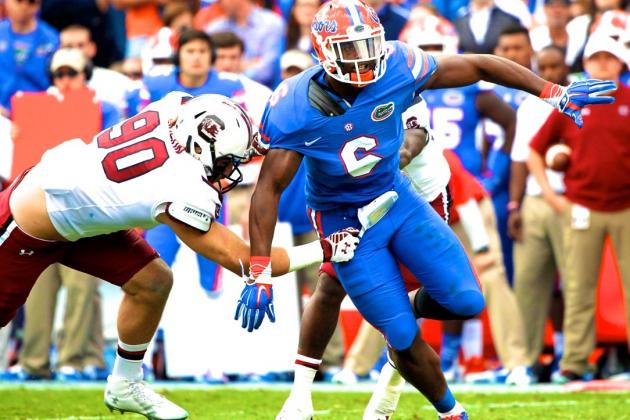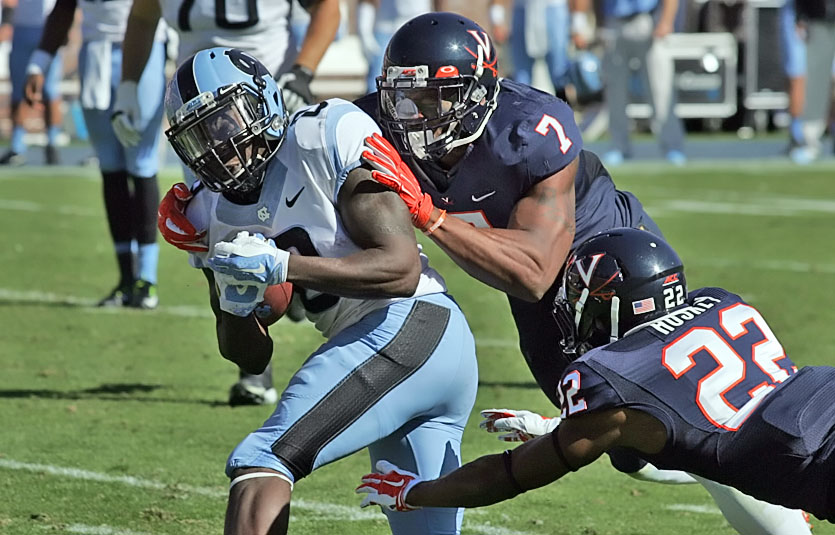The importance of pressuring the quarterback has always been
obvious, but it has become increasingly valuable in recent years. A strong pass
rush can single handedly elevate a mediocre defense (Detroit
and Miami, for example), just as a mediocre pass
rush can sink an otherwise talented unit (Cincinnati,
Tampa Bay). There are a lot of talented pass
rushers available in this year’s draft, with potentially eight worthy of going
in the first round. Of these, there is a clear gap between the top four and the
second tier. Four potential superstars are available, with a bevy of quality
starters available for those who miss out.
Dante Fowler – Florida

Fowler’s game is predicated on explosiveness. He is quick
off the ball out of either a two or a three point stance, able to blow around
the corner or shoot through a gap before opposing linemen can get out of their
stances. He has the size and the strength to ignore blockers once he has an
angle towards the quarterback. At times he can play a bit too out of control in
the backfield, missing opportunities to increase his rather pedestrian sack
totals. But even when he doesn’t bring the quarterback down he is wreaking
havoc in the backfield, and it should be a relatively easy fix to bring him to
consistent double digit sack production.
The biggest criticism that can be levied against Fowler is
with his hands. He doesn’t create good extension with his arms, and he ends up
wasting a lot of energy grappling in and around a blocker’s chest. At times he gets
absolutely stonewalled when he can’t win on the initial burst. But at others he
shows flashes of potential with secondary moves. He can spin back inside, he
can swim over the top, and he can throw linemen to the side to open up a lane
to the quarterback.
Fowler is a developmental prospect in a lot of ways, but
he’s good enough that he can contribute right now at a number of positions. His
ceiling is as a perennial All Pro player, provided he can develop more
consistency with his secondary moves and improve in holding his ground against
the run. A player of his talent shouldn’t fall outside of the top five, and
right now I’d find it difficult to put any non-quarterback
position above him.
Randy Gregory – Nebraska

The biggest concern about Gregory is his size. He weighed
only 235 pounds at the combine despite standing 6’5” tall. He is incredibly
lanky, and it is easy to imagine him being pushed around by linemen who
outweigh him by nearly a hundred pounds. The strange thing is, that doesn’t
seem to happen on film. He boasts surprising strength, makes excellent use of leverage,
and has one of the best bull rushes of any pass rusher in the draft. He may be
only 235 pounds and he may have only managed 24 reps in the bench press, but
his functional size and strength greatly outpaces these numbers
The secret to Gregory’s success is his handwork. He always
leads with his hands, striking a lineman beneath his shoulders and bending him
backwards to create separation with his long arms. It’s a rare college prospect
who can create this kind of separation, and an even rarer one who can make use
of it like Gregory does. He can drive a lineman backwards into the quarterback.
He can rip his way past either to the inside or the outside. He can do
essentially anything he wants with the lineman in front of him once his hands
are engaged, making him a dangerous rusher even after his initial rush fails.
There are a few things he needs to clean up at the next
level. He sometimes gives up too quickly on the play, and he needs to learn to
be more aggressive. He is merely average against the run when his skill with
his hands should make him much more. He’ll gain these skills over time, but
until then he’ll be able to contribute as a starter from the moment he enters
the league.
Vic Beasley – Clemson

Most of Beasley’s sacks are earned at the snap of the ball.
He is incredibly quick into the backfield, especially when he starts with his
hand in the dirt. He can penetrate on the inside or race around the edge, and
it is a rare tackle with the footwork sharp enough to handle him. At times he
plays smaller than he weighs, getting pushed off his rushing lane and giving
the quarterback too much room to maneuver in the pocket. But he does a good job
preventing this by evading a blocker’s hands, keeping low to get into the
lineman’s chest and swatting himself free with his own arms.
Beasley’s strength was impressive at the combine, but it
doesn’t always translate to the field. He gets pushed around too easily in the
running game, and he really only contributes on that side of the ball when he
can penetrate and disrupt the play in the backfield. He needs to get better at
setting an edge and preventing himself from being sealed off.
The same strength would benefit him as a pass rusher,
allowing him to create more separation with his arms to transition into
secondary moves. His lateral quickness is phenomenal, but he very rarely beats
a blocker once they are engaged, with one notable exception. His spin move is
absolutely devastating, far and away the best individual move of any pass
rusher in the draft. It is something to build on, but he will need to develop a
more complex game going forward. His speed makes him a top ten pick, but a lack
of versatility holds him behind the other rushers.
Shane Ray – Missouri

Ray’s athletic numbers are concerning, but he looks more
than functional on the field. He gets off the ball extremely well, and he
displays excellent lateral quickness when he makes cuts back to the inside. His
strength is a minor concern, and he can get knocked off his route when a
blocker gets his hands on him. But he does a good job avoiding these hands,
staying low and playing at a sharp angle to cut under a taller tackle’s arms.
He is still very dangerous around the edge, but his
shortcomings show up in other areas. He can create separation with his arms
like Gregory, but he doesn’t have the strength to turn this leverage into
power. Linemen anchor against him, and there is very little he can do to knock
them back or to disengage. His hands don’t offer him much help, and once his
first move fails he relies almost solely on tenacity to get to the quarterback.
Ray’s upside is more limited than the other top prospects,
but he could still turn into a top quality pass rusher in the NFL. His lack of
athleticism may prevent him from being a linebacker, but for a pure 4-3 team he
will make an excellent starting defensive end for years to come. If the other
three are off the board, I don’t think it would be a reach for a team to take
him in the top ten, provided his limited versatility fits what they are looking
for in a pass rusher.
Owa Odighizuwa – UCLA

A lack of versatility hurts Odighizuwa from the start. At
267 pounds he is too large to play linebacker and too small to play defensive
end in the 3-4. He might be able to bulk up some, but I think he is probably
limited to teams that either run a consistent 4-3 or use a lot of hybrid looks.
As a defensive end, he can bounce around several places on the line, but he
doesn’t have the strength to hold up in the interior outside of occasional
passing circumstances.
Odighizuwa’s greatest assets are his hands. He initiates
contact with the lineman in front of him, using his long and strong arms to
create separation and gain control. He isn’t able to do much from there to beat
his man, but he does a good job reading the play and shedding when the ball
comes his way. This makes him an excellent run defender (easily the best of the
eight players on this list) but it limits his ability to contribute as a pass
rusher. His combine numbers were excellent, but this speed doesn’t translate
onto the field. He won’t be beating any offensive tackles around the corner,
and when he does collect sacks it is usually due to coverage and tenacity.
There is potential for Odighizuwa to develop a more complete
pass rushing game down the road, but he strikes me as the sort of player who
will always be limited. That doesn’t mean he can’t be useful however. The best
situation would be as a secondary option on a team with an established pass
rusher opposite him, someone to take the pressure off so he can focus on the
run while collecting a sack here or there. He will never accumulate large sack
numbers, but he’s still worth a late first round pick.
Nate Orchard – Utah

Like Odighizuwa, Orchard offers limited versatility. He might be able to play as a 3-4 outside linebacker, but his size and lack of speed
will likely cause problems anywhere other than a 4-3 defensive end. Also like
Odighizuwa, Orchard doesn’t contribute much as a speed rusher around the edge.
He’s strong enough that he is difficult to knock off his path when he does try
to turn the corner, but no NFL tackle is going to have an issue staying square
in front of him.
Orchard’s success as a pass rusher comes after the initial
burst. He strikes quick and hard with his hands, gaining control of the blocker
across from him and using that control to pull off a wide variety of moves. He
can toss a lineman away to open up a lane, he can break back inside to get to
the quarterback, or he can simply walk the tackle backwards until an
opportunity presents itself. Orchard’s pure strength isn’t particularly
impressive, but his use of leverage and handfighting gives him the ability to
overpower linemen as a pass rusher.
He isn’t as good against the run as he probably should be.
He doesn’t disengage as well when he reads run, and linemen attacking downhill
can usually shove him backwards. He will need to get better as a run defender
if he’s going to find long term success in the NFL, since he doesn’t have the
physical gifts to be a pure pass rusher. Orchard will be a starter down the
road in a very similar role to Odighizuwa, but I have to knock him lower on my
board due to his lack of athletic upside.
Bud Dupree – Kentucky

His combine numbers suggest a player who is dangerously
explosive, and his film backs that up. He shoots off the line with tremendous burst,
creating lanes towards the quarterback based on his initial getoff. He can race
around the edge or shoot through the middle, and he is often completely
untouched as he goes after the quarterback. Even when someone does get a hand
on him, he has the strength to turn the corner and speed to close in on the
ball.
Dupree can create opportunities for himself off the snap of
the ball, but he doesn’t do much if his initial burst fails to give him an
edge. He has the strength required to free himself with his hands, but he
doesn’t make use of them often enough to consider this a true asset of his
game. His lateral quickness leaves a lot to be desired, and once he’s engaged
the play is essentially over for him.
Dupree collected sacks in large numbers in college, but this
production overrates his pass rushing abilities. Many of his big plays came
when he was totally unblocked due to well designed blitzes that confused the
opposing offensive line. He does deserve some credit for this, timing his rush
perfectly to find the gaps and closing in on the quarterback before he can
react. In the NFL smart coaches will know how to use him as they
develop more complex pass rushing moves. I could see him in a very similar role
to the one Anthony Barr found with the Vikings last year, playing off the ball
but spending a lot of time blitzing through the A gap. Dupree has a lot of
ability, and he could end up being the best pass rusher from his class. But I
have to disagree with the people who have him ranked as one of the top ten
players. He is still on the second tier, even if he is the most intriguing
option among this group.
Eli Harold – Virginia

He’s better coming out of a three point stance than standing
up, but he has the athleticism necessary to transition to linebacker in the
NFL, even though it will be a steep learning curve. He has no experience in
pass coverage, and he doesn’t track the ball particularly well through a crowd.
He’d probably be best with a team that will use him as a pass rusher only at
first, a defensive end going by the name of linebacker where he can use his
speed to chase around the edge or shoot through an interior gap.
Speed is Harold’s most attractive asset, largely because
it’s the only one he brings to the table. When he can’t find an angle past a
lineman, there’s really nothing he can do. He doesn’t use his hands at all, and
blockers have no trouble staying latched onto him once they’re engaged. He has
no secondary moves, and he doesn’t have the strength to pull off any sort of
bull rush. In the running game he is almost nonexistent, failing to set an edge
and consistently being driven backwards from the line.
Harold is quick, but the NFL is full of quick pass rushers.
More importantly, the NFL is full of offensive linemen who know how to handle
quick pass rushers. Until he can add strength and develop some polish to his
game, Harold will be consigned to a role as a situational pass rusher. He might
be able to grab five sacks a year with what he has right now, and the team that
drafts him just has to hope they can get something more out of him down the
road. The risk is high enough that I wouldn’t take him in the first round.
No comments:
Post a Comment